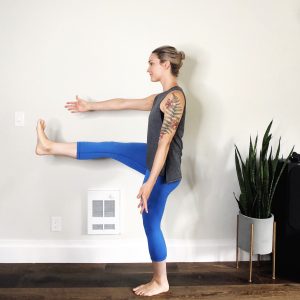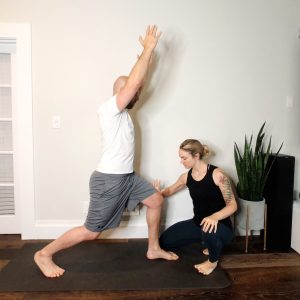Ahh, yoga pet peeves. We all have them. As someone who studies movement science and also loves her yoga, I admittedly have a few. One of my biggest gripes is when teachers touch me without asking. Out in the real world, this (thankfully) isn’t a problem, but in the yoga room, it’s strangely rare for teachers to ask permission before they start tugging me around.
As soon as I step on my mat, I’m expected to be fine with getting twisted, pulled, pushed, and ‘corrected’ by someone who likely doesn’t know my name, much less my physical limitations or health history.
Uuuugh. So obnoxious!
But I gotta say, I think my biggest pet peeve of all is how prevalent passive yoga adjustments are in general.
The truth is, the most commonly practiced methods of adjustment, done with the purpose of helping students ‘go deeper’ into postures, are alarmingly outdated. They go against most of the current research about how to develop healthy mobility. They also limit students from appreciating their unique physiology, and they promote the false hype that there is one correct shape that we all should be able to accomplish someday in our yoga future.
Pet peeves and eye-rolls aside, a lot of injuries happen because of this outdated style of adjusting. I had a highly respected teacher quickly and forcibly push both my knees down to the floor in Baddha Konasana. He didn’t ask permission, nor did he pay my resulting medical bills (though I’m still toying with the cheeky idea of sending him an invoice). Sadly, my story isn’t unusual. Unnecessary injuries happen a lot, thus my cantankerousness.
I genuinely understand how tricky the topic of yoga adjustments is, though. There’s a lot of pressure on teachers to get off the mat and assist their students to go deeper into their postures. But not only is this pressure completely undue, it’s also empirically unsound. Considering what we now know about the body and how it moves and learns, traditional physical adjustments should be a thing of ancient yoga history and replaced with a fresh, modernized and evidence-based approach.
Passive vs. active range of motion
Let’s chat in more scientific terms about why we should give traditional adjustments the boot, starting with the relationship between the body’s two types of ranges of motion.
First, we have ‘passive range of motion,’ which is a range we achieve with the help of gravity, or by pulling or pushing ourselves into a stretch.
Example: if you stand on one leg and use your hand or a yoga strap to pull your other leg up as high up as possible, you’re going into a passive range of motion.

Now, when your hand lets go of the outstretched leg, and you have to use your strength to keep holding the leg up, you are now using your active range of motion. This is a range that is achieved without the help of anything but your own physical control.
Okay, now here’s the real kicker in this scenario:
When you let go of that outstretched leg, can you actively keep it at the same height as it was when you pulled it in place with the hand or strap? If not, then how much does it drop?
The answer to that question defines the difference between your active and passive range, or your ‘active to passive deficit.’

If you have a large deficit (typically more than 15 degrees) between how much range you can actively control and how much deeper your flexibility can go, then you’ll, unfortunately, have a higher chance of injuring yourself in the passive range. This is because your nervous system doesn’t ‘own’ that area of deep flexibility and cannot readily safeguard in it. It’s like building a car that can get to 120 mph but has brakes that stop working once you reach 70 mph. Not ideal, right?
Okay, so back to the idea of adjusting someone deeper into a pose. To do this safely, we’d first have to test that person’s active to passive deficit in all possible positions. This is the only way we’d know for sure we aren’t giving them an even higher deficit–and a higher chance for injury–through our assists.
Since we don’t have that depth of knowledge about our students’ tissue threshold, it’s just generally a bad idea.
However, a way we can use a manual assist that will benefit a student in that same standing example is if we have the student place a hand on a wall for balance and stretch one leg out in front of them with a hand or strap. Then, we carefully place our palm right underneath the heel of their outstretched foot (being careful not to push it any deeper into the stretch) and cue them to strongly engage their entire leg and hip flexors and to gently release the grip of their own hand or strap.
Now, we very slowly start to lower our palm down and away from their heel until they’re actively holding their leg out on their own. This way, they’re using our assist to go from a passive stretch to an active one in a slow and controlled manner, thus learning to close their passive to active deficit.
Passive training does not translate into active results
Okay cool, but what about alignment principles? If we see someone whose alignment is ‘off’ and we want to help them, can’t we just adjust them into the right shape?
Well, it depends. Here’s why:
There’s a concept in movement science that states that when someone is stretched or molded into a position by someone or something else, they won’t necessarily be able to find that position again for themselves.
The nervous system doesn’t pay as much attention to passive movement (e.g., traditional adjustments). Our bodies are inherently lazy. They want to preserve as much energy and remember as little as possible in order to get their jobs done.
So the nervous system may allow a stretch to happen, but that doesn’t mean that we’ll be able to do this movement actively on our own afterward.
Say someone looks like they aren’t as deep in child’s pose as you think they could be, so you press their hips down towards the floor and slide your hand up along their spine, helping them discover more depth. Their body allows those movement changes to happen passively at that moment, but they essentially go “unrecorded”.
This is because helping someone gain a deeper range doesn’t help them own that newly acquired range. You can’t increase flexibility and expect strength to just ‘happen.’ You’ve got to learn how to use that range and purposely train strength into it.
Now, the case where a manual assist can be of benefit here is if it’s to help the student discover activation in the pose. You can use your gentle pressing down of the hips with a vocal cue for the student to then engage their hip flexors, which changes the assist into a useful activation training tool.

The passive-style adjustments, on the other hand, make students depend on you to adjust them over and over again.
Which leads me to my last–and probably most important–point.
“Getting the correct shape” vs. “Respecting our own unique physiology”
When we adjust someone with the sole purpose of getting them into the ‘correctly aligned’ shape, we’re trying to mold them from the outside in. But each of our bodies is so magnificently unique that we shouldn’t be universally confined into a single shape made up of angles and lines. Downward Dog can’t possibly look the same in every body. Same with Triangle, Pigeon, all of the Warriors, and literally every single yoga pose as well as everything else in the infinite movement sphere.
The idea that we should aspire to perform the postures ‘correctly’ according to the arbitrary alignment rulebook is inherently flawed, and it impedes our bodies’ natural intelligence.
Of course, there are certain art forms like ballet that demand specific alignment (done at the expense of health and longevity). But yoga isn’t an art form. It’s a process of self-discovery and cultivation of well-being.
Our bodies don’t naturally move in lines. We move fluidly, in all directions, and the way each of us does this is different from one person to the next. This isn’t something to be feared or inhibited; it’s something to be friggin celebrated.
The principles of alignment can be a useful tool for us as teachers to understand a ‘baseline’ for a posture. But we have to remember that these postures have to look different, even ever so slightly, from person to person. When we forcibly move someone into the ‘correct’ shape, we’re stripping away their uniqueness and their empowerment. This is true not just on a mental and emotional level, but on a physiological level as well.

Remember, the body wants activation to learn. It needs to do things on its own. So instead of passively adjusting, help your students to find muscular engagement in their postures, prompt them to feel the postures, and let them explore their own experience of yoga, regardless of what it looks like.
As yoga teachers, what greater gift can we give to our students than to let them navigate this practice in their own way, to adapt it to their own ever-changing and ever-evolving needs?
So with a modernized manual adjustment approach in our teaching, we can make our classes safer, more effective, and more empowering for everyone involved.

Illustration by Katya Uspenskaya
Edited by Jaimee Hoefert, the Scientist Yogini





